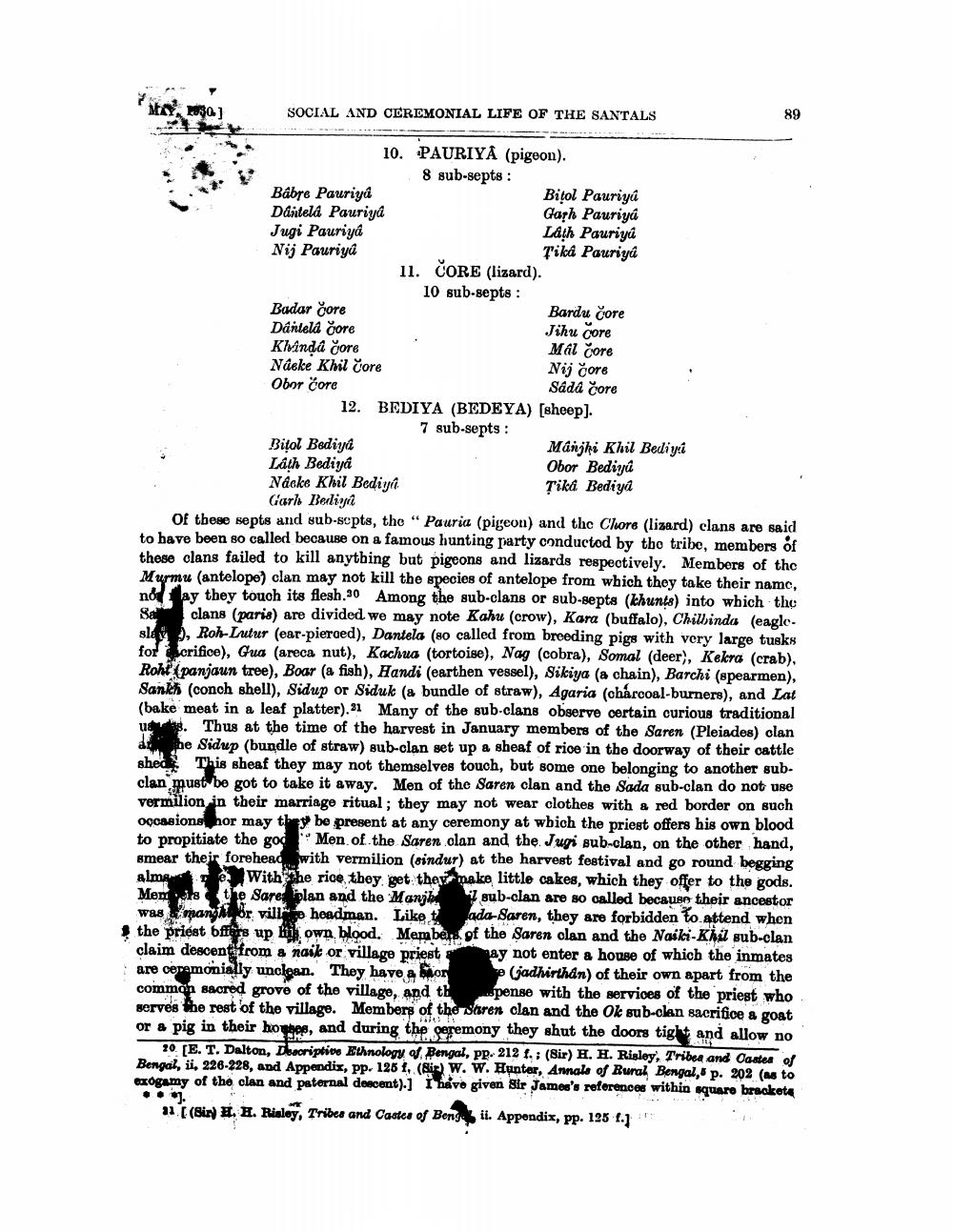________________
MA
SOCIAL AND CEREMONIAL LIFE OF THE SANTALS
89
10. PAURIYA (pigeon).
8 sub-septs : Bábre Pauriya
Bitol Pauriyú Dantela Pauriya
Garh Pauriya Jugi Pauriya
Lath Pauriya Nij Pauriya
Tika Pauriya 11. CORE (lizard).
10 sub-septs : Badar core
Bardu čore Dantela core
Jihu core Klinda core
Mal core Ndeke Khil core
Nij core Obor Core
Sada čore 12. BEDIYA (BEDEYA) (sheep).
7 sub-septs : Bitol Bediya
Manjhi Khil Bediyi Láth Bediya
Obor Bediya Näcke Khil Bediya
Tika Bediya Garh Berliyat Of these septs and sub-scpts, the “Pauria (pigeon) and the Clors (Lizard) clans are said to have been so called because on a famous hunting party conductod by the tribe, members of these clans failed to kill anything but pigeons and lizards respectively. Members of the Murmu (antelopo) clan may not kill the species of antelope from which they take their name, no hay they touch its flesh.30 Among the sub-clans or sub-septs (khunts) into which the Sa c lans paris) are divided we may note Kahu (crow), Kara (buffalo), Chillinda (eagleslav.), Roh-Lutur (ear-pieroed), Dantela (so called from breeding pigs with very large tusks fodorifice), Gua (areca nut), Kachua (tortoise), Nag (cobra), Somal (deer), Kekra (crab), Rohli panjaun tree), Boar (a fish), Handi (earthen vessel), Sikiya (a chain), Barchi (spearmen), Sankh (conch shell), Sidup or Siduk (a bundle of straw), Agaria (charcoal-burners), and Lat (bake meat in a leaf platter).21 Many of the sub-clans observe certain curious traditional us . Thus at the time of the harvest in January members of the Saren (Pleiades) olan de pe Sidup (bundle of straw) sub-clan set up a sheaf of rice in the doorway of their cattle shed. This sheaf they may not themselves touch, but some one belonging to another subclan must be got to take it away. Men of the Saren clan and the Sada sub-clan do not use vermilion in their marriage ritual; they may not wear clothes with a red border on such occasions hor may they be present at any ceremony at which the priest offers his own blood to propitiate the god . Men of the Saren olan and the Jugi sub-clan, on the other hand, smear their forehead with vermilion (sindur) at the harvest festival and go round begging alm e With the rice they get they make little cakes, which they offer to the gods. Men is the Sare plan and the Manjhe sub-clan are so called because their ancestor was mangar vill to headman. Like t ada-Saren, they are forbidden to attend when the priest offers up his own blood. Members of the şaren clan and the Naili-Kiil sub-clan claim descent from a naik or village priest way not enter a house of which the inmates are ceremonially uncloan. They have a bor j adhirthan) of their own apart from the common sacred grove of the village, and the pense with the services of the priest who serves the rest of the village. Members of the saren clan and the Ok sub-clan sacrifice & goat or & pig in their homes, and during the peremony they shut the doors tight and allow no
20 [E. T. Dalton, Dbscriptive Ethnology o Bengal, pp. 212 1. (Bir) H. H. Risley, Tribes and Oaster of Bengal, ii, 226-228, and Appendix, pp. 126 . (li) W. W. Hunter, Annals of Rural Bengal,' p. 202 (as to exogamy of the clan and paternal descent).] I have given Sir James's references within square bracketa
(Sin) . H. Risloy, Tribes and Castes of Beng, ii. Appendix, pp. 128 .)




